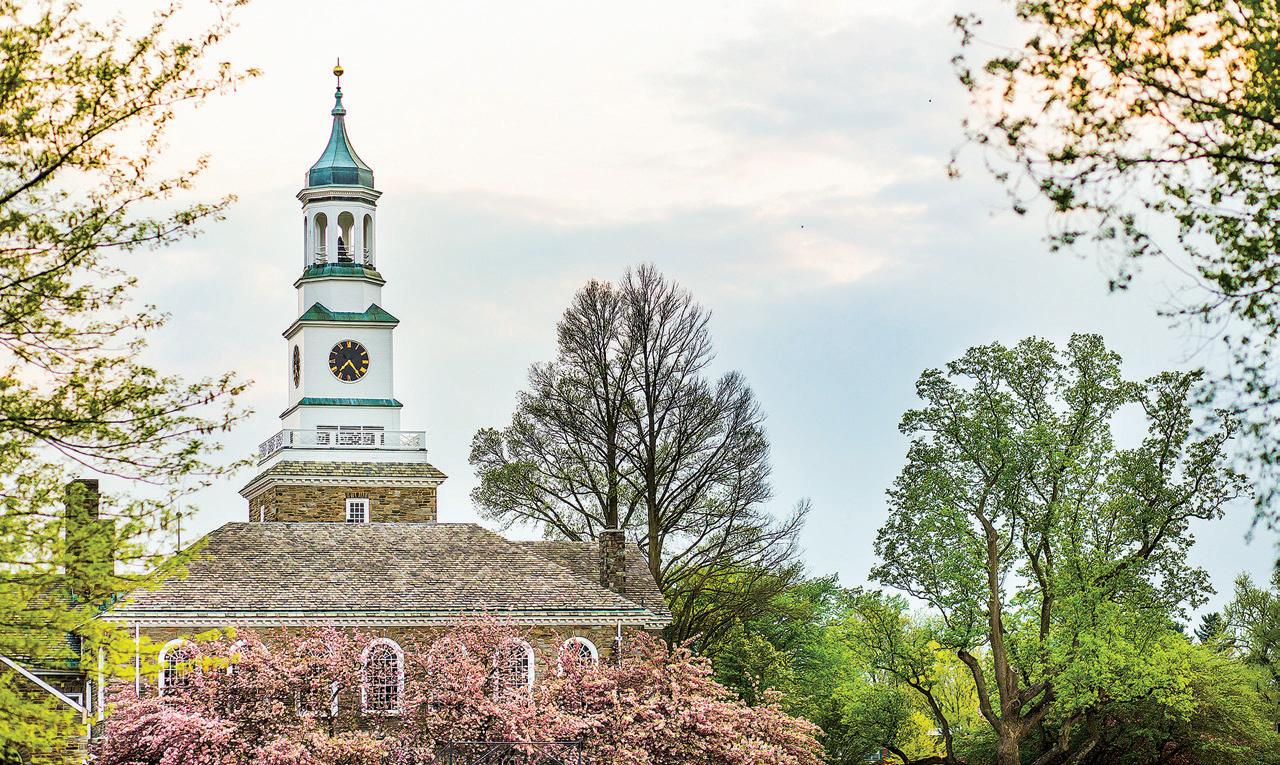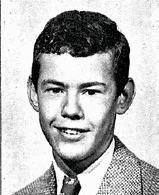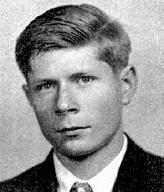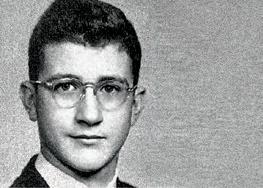REPORT OF GIFTS 2021–2022 Stories of Stewardship



Chief Development Officer
John T. Rogers Hon. 1689, P ’99, ’00, ’04

Assistant Director of Development
Nicole Martz P ’22, ’24
Director of Stewardship and Special Projects
Stephen A. Bonnie OPC ’66
Senior Development Officer
Christopher Rahill OPC ’99, P ’34
Director of the Annual Fund
Emma Rowan
Director of Parent Engagement
Lauren Stabert P ’35
Director of Alumni Relations
MaryKate Boland OPC ’12
Administrative Assistant and Event Coordinator
Darryl J. Ford Hon. 1689This year, I am especially moved by gifts to name the new lower school and spaces therein, as well as gifts to scholarship, the Grace Fund and faculty support. I am cognizant that this year’s donors to our school are especially meaningful to me as I conclude my service as head of school. These donors (and their stories) include graduates and their spouses from before my time as head of school who have become my friends, as well as my own former students, and recent and current families whose children I have watched progress from pre-K to commencement.
And, of course, there are donations, stories and people from a time eternal, many of whom none of us personally have met, but Penn Charter’s impact on them was so important that they wanted to have an impact on Penn Charter.
This is Penn Charter: a school and a community that bear witness to the inner light in students, a people resolved to give back to their school, and a faculty who strive each and every day to educate students to live lives that make a difference.
I am overwhelmed by this past year’s record-breaking level of support to our school and thankful to each of you for your support of old Penn Charter.
Sincerely,
Darryl J. Ford Hon. 1689ON THE COVER: The theme of this school year is stewardship— of the earth and of each other.
Shawna Hanley P ’34, ’35
Director of Advancement Services
Shannon Morel Makhija P ’21, ’25
Development Associate
Blanca Womack P ’20
Development Assistant
Denarii Beard OPC ’17
Brigitte Addimando P ’28, ’29, ’33
Christine B. Angelakis P ’11, ’13, ’18
Anne Marble Caramanico Hon. 1689, P ’07
Grace Sharples Cooke P ’08, ’11
David Evans OPC ’59
Jane F. Evans Hon. 1689, P ’93, ’95, ’98
Amy E. Gadsden P ’23, ’23, ’27
Mark D. Hecker OPC ’99
Paul H. Hough OPC ’77
Teresa A. Nance
Jeffrey A. Reinhold P ’12
Benjamin E. Robinson III OPC ’82
Robert L. Rosania OPC ’82, P ’22, ’23
W. Scott Simon OPC ’78
Gregory E. Summers OPC ’89, P ’23, ’26
Larry L. Turner P ’19, ’22

F. John White OPC ’65, P ’90, ’96, ’99
Caesar D. Williams Jr. OPC ’80, P ’15
Richard A. Balderston OPC ’69, P ’02, ’05
George C. Corson OPC ’52, P ’83
Nelson J. Luria OPC ’59
William F. MacDonald Jr. OPC ’62, P ’05
Edward Zubrow Hon. 1689
I am pleased to present to you the Report of
2021–2022. Once again, the generosity of our community is unmatched. Each and every year, the impact that a Penn Charter education has had on donors is revisited and made clear.
CASH RECEIVED, JULY 1, 2021 – JUNE 30, 2022
THIS YEAR, to save money and trees, we published the details of the 2021-22 Report of Gifts online at penncharter.com/gifts. The material is protected with a password to ensure the privacy of our donors.
To access details about charitable giving at PC enter the password: stewards


All at once, the future became brighter and bolder for Richard A. Balderston. “Instantly, I knew this was a different kind of education,” he said, recalling first coming to School House Lane in the fall of 1963 and entering seventh
grade. “It was like going from black and white to total color.”
Today Balderston’s enthusiasm remains youthful as he aims to make the same difference for the youngest Penn Charter learners. In recognition
of his exemplary leadership and extraordinary financial support of the How Far? campaign’s culminating project, when the ribbon is cut in 2024, our community will open the Richard A. Balderston OPC ’69 Lower School.
This landmark moment and the innovative, design-forward spaces that will welcome students and teachers promise to be a fitting tribute to a man who has spent half his life in service to this school and whose heritage has deep roots on our campus, which his own philanthropy has helped transform.
A 10th-generation Quaker, Balderston came to appreciate his family ties to Penn Charter, which he traces back to his many-times-great-grandmother and PC student Betsy Ross and at least two 18th century trustees, Samuel L. Balderston and George Claypoole.
The school deepened and broadened his Quaker values. “An important part is knowing there is God in every person, that everyone has a voice,” he reflected. “The Quaker piece for us also includes athletics, something many other Quaker schools in Philadelphia do not support as much. Having a football team, for example, is just a little bit different, but it’s really in the spirit of trying to do your best in everything.”
Balderston recognizes a Quaker through-line to the Strategic Vision underlying the current campaign. “The start of How Far? marked a true coming together as a community,” he said. “Darryl Ford is not a Quaker by birth, but he is certainly a Quaker by his evolution. He was the one who involved everyone and made the conversation happen, which took two to three years. Dr. Ford got us to the point where we shared a vision and reached consensus on what we needed most.”
A new lower school was at the core of the Strategic Vision and the campus master plan that followed, and Balderston credits his father, who joined the board in the 1960s, with instilling an understanding of the importance of our first division.

“My father was clerk of the renovation of the Lower School in the 1990s,” Balderston recalled. “That always tied me to the Lower School because my dad was very proud of how that project wound up.”
By that time, Balderston—well into his practice as an orthopedic surgeon, later to become a medical entrepreneur—had himself joined the board. Also key to
continued on next page
his allegiance to the Lower School, his children, both eventually “lifers,” enrolled in Penn Charter: son Philip in 1990 and daughter Jessica in 1993. Like Balderston, their education paved the way for success in college and careers.
“Every year I was associated with the school, more important revelations were coming to light about the effect of the teachers, the relationship with the students. Increasingly, this new knowledge focused on the Lower School,” Balderson said. “The science told us if we prioritize education from day one, lower school children will have the most transformative student experiences.”
New revelations about what a lower school needs to be—light-infused, merging indoor and outdoor, inviting of exploration—were front and center as the campaign took shape and the Board of Trustees began working with EwingCole architects. Balderston found inspiration in the gathering momentum.

“I’ve never been part of a project like this. I don’t think anybody has,” he marveled. “Ten years ago, it seemed pretty daring. And remember that I am not an artist. I’m not a builder, but I
have very good friends as trustees who understand the architecture, who are versed in early childhood development. I get to see the look on their faces when they are thrilled with what’s going on. I know that if a project is done the right way, like the lower school, the possibility of enhancing lives is so much greater.”
Over the years, Richard and Claudia Balderston have most often directed their Penn Charter giving to financial aid,
reflecting the fact that, as Richard puts it, “the scholarships I received throughout my years at Penn Charter allowed me to be around smart people—my teachers, my classmates. It’s a wonderful opportunity I need to share with others.” An exception was their leadership gift, when the Middle School was built, to create the Balderston Commons.
The How Far? campaign once again shifted the focus of their philanthropy from financial aid to facilities. “It was halfway through the campaign, maybe five years ago, when it became clear we were not raising enough money for the new lower school,” Balderston remembered. “I said to my wife, ‘I feel like I have to support the lower school.’ She agreed. We knew it was the right thing to do.”
Just as surely, Balderston knew success depended on a community of many colleagues working together in pursuit of a shared vision. “The great thing,” he said, “about being a trustee

for 35 years at a school that’s meant everything to me and my family is you get to see wonderful things through all these people, over a long period of time. They never let up. You actually come to expect the next pivot. I don’t know how many boards can say that.”
What will opening the Balderston Lower School feel like? “We all have to do it for the children,” he said. “When you see an important goal out there and you think, ‘Yes, we can do this,’ then why not try your best to make it a reality—for all Penn Charter students to come.” PC

The future Winokur Family Library is a philanthropic expression of a family’s commitment to education and a son’s gratitude.
Every new Penn Charter building focuses on the best student experiences and the brightest futures. Each also holds touchstones to the past: to the OPC and parent leaders who made the spaces possible, and to the educators or loved ones who first set individuals on the path to success.
Our new lower school embodies this combination. The inspiring building will make its mark on decades of students, bringing together the whole division in an environment designed for our youngest learners and the next century of lower school education. And perhaps no other building can pay better tribute to the first mentors and role models in a person’s life. This idea is moving How Far? donors to name spaces inside the lower school for influential teachers and loved ones.
Herbert S. “Pug” Winokur Jr. OPC ’61 is among these donors. In naming the Winokur Family Library in the new lower school, he intends his gift to honor the past and light the way for the future.

“Philanthropy is personal, and our family has always been about education,” Winokur said. “I want to show my own children and grandchildren the importance of investing in education.
My parents believed in the motto ‘Good Instruction Is Better than Riches.’ They loved Penn Charter and made my education a top priority. I owe them a lot for making a fortuitous decision that changed the trajectory of my life.
“How do you pay that debt—and pay it forward? By helping the next generation have the same opportunities I had,” he explained. “And how do you do this in a way that is
The Winokur Family Library becomes the next iteration of an essential learning hub for Penn Charter students, who learn the joy of reading and power of research in a library setting. It will replace the Trask Library, named for Lower School teacher and administrator Pauline Trask, who tragically died in a 1937 airplane crash. Her memory will continue to be honored through the Pauline Trask Library Fund.

Herbert S. “Pug” Winokur Jr. OPC ’61 recently had the opportunity to view the architect’s rendering of the lower school library, which will be named for his family.
One of the things that strikes me is the way the inside and outside are brought together. The way light is used in the design accentuates and amplifies the space. It’s the first thing you see. The second is how there are clearly places for students to congregate and read, to do research together and use digital tools. The library is where so many young people
will be learning these skills for the first time. So it reflects the current ways in which learning occurs. I see comfortable, movable seating and also plants, which I never remember seeing in any library. They fit in with the design, which suggests treetops, and it all combines to create a user-friendly environment. Wow, what a great use of space!
respectful of the choices people, like my parents, made for you? With a gift like this one. It’s easy to be a supporter of institutions that are excellent in terms of governance, vision, leadership in education, and diversity and opportunity. When I look at Penn Charter, it checks all of these boxes.”
Focusing on the library harkens back to Winokur’s days as a student, which propelled him to a Harvard degree and successful business career. “I was involved in a number of activities outside of classes and sports. At the top was the Greek Society with our class’s favorite teacher, Fritz
Kempner, where I learned objective reasoning, and the Library Society, which our group started with Edwin Owrid, the long-time librarian. They were powerful mentors.” PC
With plans finalized and a groundbreaking set for this school year, Penn Charter donors have many opportunities to follow Winokur’s example. Individuals interested in naming a space in the new lower school should contact Senior Development Officer Chris Rahill OPC ’99, P ’34.
Philanthropy at Penn Charter is thriving. It thrives because it engages a large and representative cross-section of the community. It thrives because through the How Far? campaign thousands of past and current parents, faculty and staff, and OPCs across generations have taken part in transforming our school. In this past decade, more than 4,700 individuals have stepped forward to make nearly 30,000 gifts.
“We believe that every gift matters,” explained William F. MacDonald Jr. OPC ’62, P ’05, co-chair of the How Far? campaign, “This understanding is helping more OPCs and parents recognize that the Annual Fund supports excellence and innovation every year in the here and now, and it must continue to do so after the campaign closes.”
Throughout the How Far? years, the growth in annual giving has been fostered by greater donor education, cultivation and stewardship. New ways to participate have appealed to the wide audience that is the Penn Charter family,
The Penn Charter Annual Fund supports all students, all faculty and all programs every day of the year, and it is stronger today than in 2013, when school leaders and key donors created the How Far? campaign. That growth translates to increased financial sustainability, a key goal of the Strategic Vision and an integral component of the school’s continued success.
including those who differ in age, career stage, motivation, connections and capacity. Great Day to Be a Quaker, an interactive day of giving instituted in 2016, has inspired annual giving every year since then—not to mention bringing us together around all that we love about PC.
As illustrated in the chart below, Annual Fund support of Penn Charter has grown 61 percent since the campaign began in 2013, and the total for the fund increased from $1.1 million to $1.8 million for 2021-2022. In addition, though PC had no $50,000 Annual Fund donors at the start of the campaign, we now have seven. That is the power of philanthropy. That is the power of community.
Every gift to Penn Charter lights the way forward. Together, we find joy in supporting educational excellence and sending into the world graduates prepared to live lives that make a difference. The following testimonials illustrate how donors who share a commitment to Penn Charter have found ways to express gratitude while supporting their individual priorities and passions.
Penn Charter parents Reshma Rangwala and Benjamin Wilkins, already leadership donors to the Annual Fund, increased their recent gift in response to Penn Charter’s Make Your Best Gift appeal during this last year of the How Far? Campaign.

Their “best gift” reflects gratitude for Penn Charter’s exceptional effort and execution during the pandemic, which began in 2020, when their son, Ramzi, was in fourth grade.
“We were aware of the struggles other schools had in maintaining in-person education and have been very grateful for what Penn Charter was able to provide despite the challenges,” Rangwala said. “I applaud the school as a whole, the leadership team, and obviously the teachers who made it possible for learning to continue.”
As scientists and physicians, the couple welcomed the “pragmatic and data-driven” approach Penn Charter used
Established in 2014, the William Penn Society recognizes leadership gifts to the Annual Fund, with giving levels named for leaders and milestones in school history. Several of the levels have grown significantly during the How Far? campaign.





to create an environment in which the risk of Covid-19 was minimized and students were able not only to learn but to socialize and maintain relationships.

“Ramzi is an only child, and during Covid the school environment served as one of the few organizing elements in his entire life,” Rangwala said. “Ben and I are grateful he was in an environment where he was protected but still thrived emotionally, socially, academically and physically.”
Ramzi is now in seventh grade, and his parents see an array of opportunities before him. “We are learning what Penn Charter has to offer through him,” she said, “and the opportunities at school are vast.”
In 2016, when Sue Brennan OPC ’04 transitioned from teaching to fundraising at Swarthmore College, she mapped a plan for her personal philanthropy that included Penn Charter. Brennan came to PC in ninth grade from a school that prized rote learning and memorization, and Penn Charter opened her eyes to inequities in education. “My Penn Charter education focused on critical thinking and values,” Brennan said. “It challenged me and shaped me as a person. My giving is a celebration of how much that means to me.”
her intention to give: Penn Charter divides the amount of her annual gift into smaller monthly payments and bills her credit card each month. “I never have to wonder in June if I remembered to send in a yellow envelope,” she said, “and thinking of my gifts in smaller monthly amounts allows me to imagine how I can have a greater impact annually.”
Brendan McNally OPC ’06 recalls the teachers, administrators, coaches, students and families who welcomed him from the beginning and throughout his two years at Penn Charter.
Brennan directs her Annual Fund gift to the Grace Fund, which provides assistance to financial aid recipients who cannot afford the extra costs of a PC education. The designation of her gift has special meaning because Brennan received financial aid. “The cost of things like field trips, shoes required for a sports team—these can make students feel very othered,” Brennan said. “Having a fund that makes it possible for students to live in the opportunity without feeling this inequity is powerful.”
Brennan, who describes her giving as pragmatic, decided a “recurring gift” was a reliable way to follow through on


“There are so many names to list, so many people who took an interest in me, took a bet on me,” he recalled. McNally enrolled for his junior year and traveled to PC from Downingtown—no easy feat, especially before he had a driver’s license. But people pulled together to help with the commuting, and families invited him to spend the night in bad weather or when a sporting event ended late. “I think of the sacrifices my parents made and also the support I received from the entire Penn Charter community—it took a village.”
McNally credits faculty for teaching him to think critically and accept differing opinions, and his coaches and teammates for helping him develop a strong work ethic and leadership skills. Welcomed himself, he was aware of a “culture of acceptance” that opened students’ eyes to different peoples and worldviews. “I wish all students had the opportunity to learn in an environment like Penn Charter,” he said.
“...theAnnualFundsupportsexcellenceandinnovationeveryyearinthe hereandnow,anditmustcontinuetodosoafterthecampaigncloses.”
McNally has made a career in commercial real estate finance and is newly married and living with his wife, Caroline, in Greenwich, Conn. He believes his Penn Charter education “opened doors of opportunity to help me achieve my potential.”
Years ago, when McNally was first asked if he would make a gift to Penn Charter’s Annual Fund, the answer was easy: He gave a generous gift for a young OPC and continues as one of PC’s youngest leadership donors.
“I’m so appreciative that I had the opportunity to attend Penn Charter,” McNally said, “and if a gift from me can help someone else have that same opportunity, I find that extremely fulfilling.”
Alexis Lo OPC ’12 served as a student representative of the group that helped develop the Strategic Vision that has guided a decade of exciting curricular innovation and, financed by the How Far? campaign, the transformation of our campus.
Her time is at a premium now—Lo is in her third year as a resident doctor in a demanding, six-year plastic surgery residency at Penn State Health Milton S. Hershey Medical Center—but she remains active as an OPC and was excited last year to tour campus.

What struck her about the new Graham Athletics & Wellness Center was the idea of balance and wholeness. “We now have more spaces for academics, an amazing arts center, plus a new athletics and wellness center—and they are all connected, not isolated from one another. I thought that was awesome and reflected that PC is an incredible school committed to helping students grow as well-rounded individuals.”
Lo said she tries to assist Penn Charter when possible by helping with OPC reunions, volunteering with the Senior Comprehensive Project, and supporting the Annual Fund and
How Far? campaign. She has been a member of the Clock Tower Society, a giving society established in 2016 for OPCs within 10 years of graduation. OPCs 0-5 years from graduation lead with a gift of $16.89 or more, annually. OPCs 6-10 years from graduation lead with a gift of $168.90 or more, annually.
“Penn Charter’s Annual Giving is a convenient way for younger OPCs to stay engaged with Penn Charter and to feel connected to the community,” she explained. And it’s another way to give back. “The school was crucial in helping me grow as a person, which is why, any time I see something from Penn Charter, my first gut reaction is one of gratitude and goodwill. Anything I can do to give back to a school that helped create who I am today, of course, I’ll do it!” PC
• RECURRING GIFTS
Set up a monthly, quarterly or annually recurring gift.
• EMPLOYER MATCH
Search matchinggifts.com/penncharter and discover if your employer matches charitable donations.
• STATE TAX LIABILITY CREDIT
Turn your individual or your business’s Pa. tax liability into financial aid for PC students.
• SECURITIES
Transfer a gift of securities.
• ONLINE
Make a gift online 24/7 at penncharter.com/give.
• YELLOW ENVELOPE!
Make a gift by check or credit card using our traditional yellow envelope, included in each issue of Penn Charter magazine.
Director of the Annual Fund Emma Rowan welcomes your questions at 215-844-3460 ext. 227 or erowan@penncharter.com.
OPCs, grateful for the values and education they received from Penn Charter, give back through endowed scholarships that support the next generation.
Peter Benoliel OPC ’49 is keenly aware of the roots of diversity at William Penn’s school, dating back to Anthony Benezet, an 18th century abolitionist as well as headmaster who established schools for girls and for students of African descent. Benoliel wants to “carry on that worthy tradition.”
In the 1970s, when Benoliel was CEO of Quaker Chemical, he suggested that the company’s nonprofit, the Quaker Chemical Foundation, financially support a student of color at Penn Charter, beginning in eighth grade and continuing through graduation. The foundation was managed by employees, and in 1978, when PC was still an all-boys school, they took Benoliel’s suggestion. The student they supported graduated from PC in 1983 and went on to the Naval Academy and Harvard Business School.

In 2021, Benoliel, retired from Quaker Chemical, returned to Penn Charter to help fund an endowed scholarship for an African-American student – boy or girl – that would cover the student’s full financial need. Named in honor of Anthony Benezet, this new scholarship is different because it provides continual opportunity and access to a Penn Charter education: After one Benezet scholar graduates, another will follow. That is the power of endowment. “A society can only be as strong as its many different parts,” Benoliel said. “And [diversity] in my opinion enriches our culture, enriches our society. My intent … is to enable and expand the number of students of color to have access in their high school years to the Penn Charter educational program.”
In conversations with Jack Rogers and Head of School Darryl J. Ford, Benoliel noted that because of his station in life, affording a Penn Charter education was possible and that others, including some African-American students, did not have this same opportunity. “I am heartened that Peter wanted to name
the scholarship in honor of Anthony Benezet,” Ford said. “Peter said that long after he was gone, he wanted Anthony Benezet’s name to be known and remain a part of Penn Charter history. What a great way to support students, and bring part of Penn Charter’s past front and center today.”
“Now that many years have passed and I have the financial resources,” Benoliel said, “I thought it would be wonderful to create an endowment that would support the effort in perpetuity.”
Brothers Aaron OPC ’02 and Jason Greenfield

OPC ’00 believe one of the first things they knew in life was that they would follow their father, Albert M. Greenfield OPC ’74, and their uncle, Douglas Greenfield OPC ’78, to Penn Charter. By their accounts, the two senior Greenfields were not only family ambassadors for Penn Charter but they embraced their experience, taking full advantage of everything PC had to offer.
Moose, as Albert was known since about age 8, claimed he had the most varsity letters in the history of Penn Charter— though he also used to say, “Never let the facts get in the way of a good story.” He wrestled, played football and baseball, was elected to the Steering Committee of the senior class, and sang in Quakers Dozen.
Throughout his life,” Jason said, “Dad was an early riser, a hard worker, driven and unbelievably competitive.” That competitive streak was on full display as a PC parent, too.
“Dad was Mr. Penn Charter,” Aaron said. “Nothing made him prouder than to be on the sidelines, decked out in his Penn Charter gear. All the parents knew who he was because he was the loudest. The spectators would say, ‘Okay, Moose is here, the game can start.’”
“Uncle Doug,” Aaron said, “was passionate about Penn Charter.” Like Moose, he sang in Quakers Dozen and played three sports: football, wrestling and track, and in each sport Doug was awarded “most improved” or “hardest worker.” He served as managing editor of the yearbook and was a member of the Assembly Committee. Bright and outgoing, Doug was known for his great sense of humor.
“He was really interested in people, really wanted to hear what you were doing,” Jason said. “An extrovert.”
So when Doug, a labor union lawyer, died in 2020 and Albert, a real estate developer, died in 2021, honoring them by establishing a scholarship fund in their names through the Albert M. Greenfield Foundation seemed like a natural choice.
“Penn Charter was a huge part of their upbringing,” Jason said, “and they always felt connected to the school.”
Working with Chief Development Officer Jack Rogers Hon. 1689, the brothers established the Albert Monroe Greenfield III and Douglas Littman Greenfield Scholarship Fund to support a rising sixth grade student each year through graduation. Like the Benezet Fund, once that student graduates, another student with demonstrated need will be selected.
“We felt it was really important that we give back,” Jason said, “and with Jack Rogers’ help we created a scholarship in their names that will continue in perpetuity. We hope that whichever student is chosen will be someone who is a devoted scholar, interested in serving the community and interested in athletics.”
The Class of 1961 set a lofty goal for its 60th reunion. The class that graduated 75 would seek to raise $75,000 to fund financial aid at Penn Charter.

Class agent David Geyer explained that among his classmates ”are some overachievers who have a real passion for supporting the school.”
That support began growing at their 45th reunion, and by their 50th, Geyer said, “there was a sense that we should give thanks, not only to the school but to each other.”
Through the years, members of the class considered themselves fortunate. “If you look at what [my classmates] accomplished in their life, in their careers and personal lives,” Geyer said, “they would make you feel proud. I’ve always been honored to keep their company and keep the spirit of the school alive in all of our lives.”
When they proposed their gift, Jack Rogers Hon. 1689, chief development officer and friend to the class, had a piece of advice: Make an even greater impact by contributing that money to the Full-Access Financial Aid Fund, established by Steve Koltes OPC ’74. Koltes’ pledge to match alumni contributions would double their gift to $150,000.
In the end, the class exceeded its goal and set a 60th reunion giving record of $79,400, which Koltes matched.
“I hope our gift will help promote a sense of inclusivity that the school has become noted for,” Geyer said, “and that we can continue to help those who otherwise wouldn’t be able to dream of going to Penn Charter but have all the abilities that we did.”
This class of what Dave Geyer fondly called “rascals” wasn’t done yet. Close for many years with Jack Rogers, they wanted to honor him with a gift to the school.
“We learned about Jack’s difficulties with reading as a youth and his lifelong dedication to helping young people to read and gain an appreciation of reading,” Rich Redeker OPC ’61 said.
An idea took root among four members of the Class of 1961: Redeker, Duncan McFarland, Pug Winokur and Ray Vickers would make gifts to the Full-Access Fund of $25,000 each to create Jack’s Corner, a reading nook in the library of the new lower school. They were joined by Marty Harrity OPC ’66, another friend of Rogers.
“Jack was and continues to be humbled by this recognition,” Redeker said. “Here is a man who has dedicated his life to that school.”
Steve Koltes OPC ’74 also matched the $125,000 gift to the FullAccess Fund to dedicate Jack’s Corner, raising it to $250,000. PC
PC donors discover how state tax-credit programs can work for them, for students and for the school.
The Ostroff and Shaw families are grateful for the opportunities their children have found at Penn Charter, and both sets of parents have chosen to support state tax-credit programs designed to expand access to those opportunities to talented students of limited financial means.
The Ostroff and Shaw families are in the real estate industry, and both families have children in the eighth grade.
Ashley and Noah Ostroff P, 27, ’27 say that sending their three children to PC was an obvious choice. “To be able to be just 17 minutes from a campus like PC and afford our children the opportunity to benefit from such a broad program, with gorgeous facilities and a commitment to keep moving forward into the future—that’s a no brainer,” Ashley said.
Jade and Logan are in the Class of 2027, and Riley attended PC from second through eighth grade and is now studying at Loomis Chaffee.
Rachel and Marc Shaw P ’27, ’31 say PC has everything a parent could ask for. “Before we stepped onto campus,” Marc said, “we felt that the school offered all of it—arts, athletics, academics. There are so many different things to like about the school. When you walk onto the campus and you live in Center City, it is grand and just blows you away.”
Independently of one another, the Shaws and the Ostroffs spoke about how happy they are that their children are thriving at PC, something they don’t take for granted. Both families spoke of the incredible opportunities their children have had, from exciting academic challenges to pursuing new skills and interests in athletics and the performing arts.

Providing broader access to educational opportunity is just what Pennsylvania tax-credit giving is all about.
Businesses and individuals with a Pennsylvania tax liability can designate part of that liability to provide financial aid to eligible students. Every dollar raised this way is directed to financial aid, helping Penn Charter attract, maintain and grow the number of talented students, with demonstrated financial need, from eligible neighborhoods with lowachieving public schools across the region.
At Penn Charter, the tax-credit program supports nearly 200 students annually.
Senior Development Officer Chris Rahill OPC ’89 believes “there is no greater gift than a Penn Charter education. And by simply redirecting tax dollars donors are creating opportunity for those who need it most.”
Rahill said that every donor who commits to the tax-credit program also is making an immediate impact on our student body and supporting the school’s mission of socioeconomic diversity. By design, families in the Penn Charter community
If you live in Pennsylvania or your company operates here, you may be eligible to participate in the tax-credit programs that permit you to redirect tax dollars to financial aid at Penn Charter. The application process is easy, and the benefits to deserving students and the school are significant. Tax-credit donors can have an immediate impact on the school, its goals and the lives of our students.
The EITC and OSTC programs make it possible for eligible Pennsylvania residents and businesses to redirect up to 90 percent of their Pennsylvania tax liability directly to financial aid for Penn Charter students and receive a tax credit.

Penn Charter donors include current and former parents, OPCs and friends of the school. Last year, tax-credit gifts to PC ranged from $5,000 to $1 million and totaled $2,834,374 in immediate financial aid for PC students.
come from all over the region, bringing different religions, worldviews and experiences to the school.
“One of the things we love most about PC,” Ashley said, “is the fact that our children have classmates from so many different backgrounds … socioeconomic, yes, but also every other demographic. “We think being a part of contributing to that goal will keep PC growing and allow it to offer the broadest programming and be the best program it can be.”
She said that the tax-credit giving program allows her family “to really pinpoint our giving to directly benefit our childrens’ school and our beloved community. It feels good to support the community we know, love and are dedicated to.”
Marc and Rachel Shaw’s philanthropic priorities are centered on the communities they care deeply about, and Penn Charter is one of them.
“When you can put [your tax liability] to work directly within the community that means so much to your family, why not do that?” Marc said of this opportunity to make such a gift to Penn Charter. “Writing the check to the Department of Revenue is a completely different dynamic at tax season. It feels good!”
When you make a gift via the tax-credit programs, the state provides a 90 percent tax rebate on that gift to financial aid at PC. In that sense, it costs only a dime to give a dollar, since you’d be paying taxes anyway, and the tax liability is directed to financial aid at Penn Charter.
Giving this way, he added, “is a small price to pay for such a big impact on the community.” PC
Example: $10,000 gift from an individual
2 DONATE: Penn Charter receives the redirected liability of $10,000 in financial aid money.
3 BACK TO YOU:
Donor receives tax credit acknowledgement from Pennsylvania for $9,000.
Over the course of more than a dozen years, Nicole and Paul Melchiorre have watched their daughters, Alexis OPC ’22 and Graziella, Class of 2024, embrace the full spectrum of the PC experience. When the Melchiorre children weren’t busy nurturing their talents for competitive dance outside of school, they were sampling the smorgasbord of sports and extracurriculars Penn Charter offers.
Field hockey, track, Service Council, Women in Business—“For Alexis and Grace there have been a lot of opportunities to try new things in a safe environment,” Nicole Melchiorre said. Often, those extracurriculars lead to life-changing experiences and insights for students. And often enough, they come with additional expenses.
Enter the Grace Fund, PC’s full-access fund designed to pay the costs of items and activities not covered by financial aid—everything from soccer cleats to art supplies to musical instruments.
Established in 2008, the Grace Fund honors the late Grace Russell Wheeler, a Penn Charter board member, parent and grandparent. Wheeler guided the
board as clerk from 1975 through 1985 and was a strong voice in the discussions that led to the board’s decision in 1980 to become coeducational.
Since its inception, hundreds of parents and OPCs have given to the fund to help students receive the full benefit of a Penn Charter education.

For the Melchiorres, it’s important that every child who passes through PC’s red doors has access to those life-changing opportunities, regardless of cost. And so, in the spring of 2022, they decided to make a lead gift to help endow the Grace Fund, ensuring that that financial
support remains available for future generations of students.
“There’s more to Penn Charter than just the academics—it’s the class trips, the school dances, the equipment for extracurricular activities,” Melchiorre said. “The Grace Fund allows everyone to experience everything that PC has to offer.”
The Melchiorres’ gift provides significant starting capital, but growing the fund to a size that’s selfsustaining will take time and additional contributions. “It’s in its infancy,” said Assistant Director of Development
In the spring of 2022, the PC Parent and Caregiver Community decided to honor the retirement of Beth Glascott Hon. 1689 with both a tree planted on campus in her honor and a gift made to the Endowed Grace Fund in her honor. Glascott administered the Grace Fund for many years during her 40-year tenure at PC, while also serving as science teacher, coach, Middle School assistant director, Upper School director, assistant head of school and associate head of school.
Nicole Martz, “and as we come out of the How Far? campaign, the endowed Grace Fund will become a greater giving priority for us. We are fortunate to have the continued annual support of our community that sustains the program while we grow the endowment.”
Since its inception, hundreds of parents and OPCs have given to the fund to help students receive the full benefit of a Penn Charter education.
Supporting the endowed Grace Fund means supporting something that drew the Melchiorres to Penn Charter in the first place: the experience of being part of a diverse community. “We wanted our girls to have that opportunity,” Melchiorre said.
them a status their mother calls “not quite lifers.” But if anything, the time away allowed Alexis, Grace and their parents to appreciate Penn Charter more.
Every academic year, a committee of senior class parents and caregivers convenes to rally their peers around a gift made in support of faculty professional development. It’s a tradition that allows senior families to express their appreciation for the teachers who have worked so closely with their children over many years.
This year’s Senior Parent and Caregiver Gift of $187,961 exceeded fundraising goals and was wrapped into a larger program of class-wide events and activities that included a senior family breakfast and the creation of “time capsule” videos in which students reflect on their favorite PC memories.
“The breakfast, the videos, I think it all contributed to creating a sense of community” for senior families, said Heather Brucker, who served on the Senior Parent and Caregiver Gift Committee and whose daughter

The Melchiorre girls came to School House Lane as kindergarteners and took a two-year hiatus when the family moved to California, earning Marissa OPC ’22 came to PC as an eighth grader. The Bruckers were so impressed with how Penn Charter adapted to the Covid pandemic that they decided to transfer their son, Matt, into the Class of 2025.
Working on a gift that supports professional development was fulfilling for Brucker and led to meaningful conversations with
With their tenure at PC finally nearing its end, the Melchiorres are eager to pay it forward. “I’m a firm believer that it takes a village to raise kids,” Melchiorre said. “And we are happy the PC community is part of our village.” PC fellow parents throughout the year. “This was a nice way for me to feel a real connection and a sense of contribution to the PC community,” she said.
Darryl Brooks, too, thinks the pandemic brought out the best in PC’s teachers, who for 13 years have felt like a “third parent” in the project of raising his son, Noah OPC ’22.
continued on next page
Brooks can recall countless other instances of exceptional, versatile teaching, like when Sonia Duprez “quarterbacked” the Class of 2022 through four years of Lower School— second, third, fourth and fifth grade— to accommodate an unusually large number of students. He still marvels at Duprez’s “ability to transcend those grades and connect with students at


whatever level they were at” and the balance she struck between sensitivity and rigor. “She gave them loving guidance, but she had her expectations, too,” he said. A gift supporting faculty professional development “strikes at the core” of what Penn Charter is all about to Brooks.
Throughout the effort, Maggie Lockwood set her sights on reaching
maximum participation, emphasizing to other parents and caregivers that any contribution is significant.
“Big donations clearly help, but it’s just as important that people participate at all,” said Lockwood, mother of Henry Ross OPC ’22, Elisabeth Ross OPC ’19 and Albert Ross, Class of 2028. She noted her satisfaction with the 93 percent engagement rate and the nearly two-dozen new donors who chipped in to the effort. “The whole point was to create this communal gift for the faculty,” she said.
Big donations do indeed help, and in this case the senior parent and caregiver initiative was buoyed by an anonymous $50,000 match, unlocked when the committee secured 22 gifts from first-time supporters.
Senior class clerk Jerry Rullo presented the gift to the faculty gathered at Commencement, remarking, “At Penn Charter, we are blessed with a beautiful campus, incredible facilities and a tradition of excellence built over three centuries. But Penn Charter’s most valuable asset, in my view, is our teachers who shape the student experience and devote themselves to our betterment.” PC
Penn Charter is fortunate to be the focus of many donors’ charitable estate planning. In just this past fiscal year, the school received bequests totalling more than $6.7 million. Seven of those bequests are described on the following pages.

According to the donors’ wishes, the school will use those gifts for financial aid, faculty support and facilities— including construction of the new lower school.
Penn Charter will also use the gifts to strengthen Penn Charter’s endowment, which PC manages as a private
individual might manage a savings account: The principal is invested, and the money realized by those investments is available for spending or further savings.
According to John White OPC ’65, P ’90, ’96, ’99, treasurer of the Board of Trustees, the school’s endowment has doubled during the course of the How Far? campaign. This is the result of new gifts, careful investing and a modest draw each year of 4 to 5 percent to support the operating needs of the school.
continued on next page
Mountaineer Robert Hicks Bates led an extraordinary life focused on teaching, travel and climbing the world’s highest peaks. Upon his death in September 2007, at age 96, Alpinist wrote: “The mountains led Bob Bates across the world from Alaska and the Yukon, where he made numerous first ascents from 1932-1942, to Pakistan, where he made early attempts on K2, to Nepal and China, where he led an expedition that made the first ascent of Ulugh Muztagh in 1985, at age seventyfour.” Bates wrote and edited about mountaineering, including his autobiography, The Love of Mountains Is Best. The photo shown was taken in the mid-1940s, when Bates was testing mountaineering clothing and equipment for the U.S. Army. Bates briefly attended Penn Charter and, along with his wife, Gail Oberlin Bates, left PC an unrestricted bequest totalling $106,800.
Louise “Bunny” Beardwood, the widow of James T. Beardwood OPC ’44, was a loyal donor to her husband’s alma mater and enjoyed her association with the school even after her husband’s death in 1983. In 2010, when renowned pianist Emanuel Ax played the Steinway donated to Penn Charter by the parents of the late Antonios “Tony” Thomas, PC Class of 2010, Bunny Beardwood attended as the special guest of Jack Rogers Hon. 1689, chief development officer at Penn Charter. Rogers drove her and Ax to Center City after the concert, and the world famous
pianist presented her with his flowers. Beardwood, a graduate of Ursinus College, earned two master’s degrees and worked in publishing at the Saturday Evening Post and later in law as a law librarian for several prominent Philadelphia firms. She died in 2020 at age 90 and left Penn Charter a $120,000 bequest to be used at the school’s discretion.

The summer newsletter of the How Far? campaign featured a story about Frederick Cressman Jr. and his $5,463,500 bequest to Penn Charter. Cressman named Penn Charter in his will and, when his estate was settled this year following the death of his wife, Elizabeth, the school received his unrestricted gift, which he indicated should be used for the school’s greatest need. Penn Charter Trustees decided that construction of the new lower school is the greatest need—and so, 72 years after his graduation and 12 years after his death, Frederick Cressman became a principal benefactor to that new facility and one of the largest donors to the school in its 333-year history.
Roger Hillas’ influence as a civic and business leader in Philadelphia is matched by his impact at Penn Charter. As a Penn Charter student, Roger managed the football team, played basketball and co-captained the track team, on which he was a star high jumper. He was an excellent student—a member of the Trident Society— who attended Dartmouth before his long and distinguished banking and civic career. He entrusted three of his children to the school: Rod OPC ’71, Heather OPC ’06 and Sean OPC ’09. Appointed to Penn Charter’s board in 1961, Roger served



for 55 years. He was instrumental in the campus expansion, orchestrating the acquisitions of the Sklar Estate (now Perrott Field) and the Strawbridge property (a deal negotiated with his friend Stockton Strawbridge). Roger supported every PC fundraising campaign and, after the 2008 economic downturn, Roger and his wife, Dee, quietly made an instrumental gift to the school to keep at Penn Charter students whose parents had lost their jobs. In addition to their gifts to the How Far? campaign to support the new lower school, after his death in 2019, Penn Charter received a $1 million bequest from Conrail Corporation, to be paid out over five years, that Roger earned as compensation for his work on the breakup of Conrail; that bequest supports faculty as well as financial aid.
The part of the Hillas’ bequest designated for financial aid qualifies for a matching gift from Penn Charter’s Full-Access Fund. Steven Koltes OPC ’74 established that fund in 2015 to increase the amount of financial aid available to Penn Charter for talented students. He matches in full gifts to financial aid from OPCs.
Hamilton “Mac” Maginniss told the local newspaper in Mansfield, Ohio, that he preferred Dixieland music to classical but was compelled to support the Mansfield Symphony Orchestra because the Orchestra was “a big deal” in the small town. As treasurer, Maginniss revamped the organization’s finances and added to its program “big names, because names bring people and people bring money and more people.” His instincts and business acumen helped other civic organizations in town and also produced success for Maginniss Vibrator Equipment Co., a manufacturer of construction equipment such as soil compactors, concrete vibrators and electrical generators, which Maginniss sold to SKIL before his death, in 1977. Maginnis and his wife, Elizabeth, left Penn Charter an unrestricted bequest of $464,534 that will be used to support construction of the new lower school.

The daily commute from Walnut Run Farm, his family’s farm in Newtown, was a trek, but Larry Russell managed the commute to Penn Charter, made the honor roll and found time for sports—he was a top-flight swimmer and played football and baseball. As a physician, he worked for many years in family practice and later traveled all over the U.S. as part of an accreditation team reviewing graduate medical programs. Russell loved to hunt and fish and devoted himself to improving and protecting Walnut Run Farm; before his death, in 2021, he entered into a conservation agreement to restrict development and protect open land. Russell was a Friend who valued athletics, and his $521,741 bequest to PC was allocated to PC’s new Athletics & Wellness Center.
The Stewart family’s connections to Penn Charter run deep: George Stewart’s two sons, George OPC ’88 and Edward, followed in their father’s footsteps and attended Penn Charter, and his wife, Mary, taught Latin. The elder George became a Philadelphia lawyer; he was cited by the Philadelphia Bar Association upon his retirement at age 81 for 50 years of distinguished service and received an award from City Council for his decades of work for the blind. Stewart belonged to the Orpheus Club, the Atheneum and the Franklin Inn, and was a lifelong sports car and classical music enthusiast. Penn Charter received a $5,000 bequest upon his death, in 2020 at age 91.


As with the Hillas gift above, because Stewart’s bequest was designated for financial aid it qualified for a $5,000 matching gift from Penn Charter’s Full-Access Fund. So, $5,000 became $10,000.
The Pinehurst Society recognizes philanthropy by those OPCs, parents and friends who have generously provided for Penn Charter through a planned gift or bequest. Pinehurst is named for the East Falls farm that became the site of the majority of our present-day campus. Philanthropy is one of the great traditions of this country and of William Penn and those who helped him envision the City of Brotherly Love.



